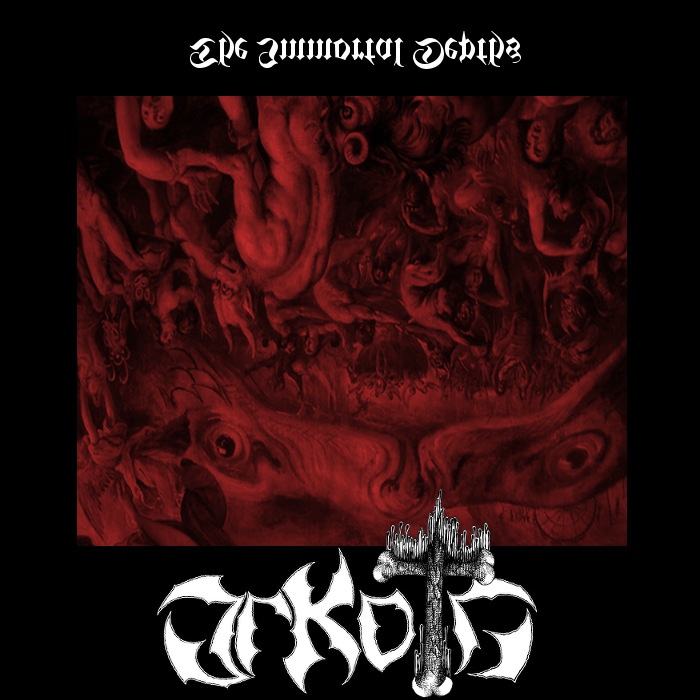
Olkoth clearly wrote a few riffs and leads that could be effective on their own.
No CommentsTags: 2016, black 'n roll, Black Metal, counter-review, medieval metal, Olkoth, psychedelic, re-review, review, wanking

Olkoth clearly wrote a few riffs and leads that could be effective on their own.
No CommentsTags: 2016, black 'n roll, Black Metal, counter-review, medieval metal, Olkoth, psychedelic, re-review, review, wanking
Article by Corey M.
Overall satisfying (but not quite inspiring) straightforward songs with equal parts thrash and proto-death metal present. I don’t quite hear the “occult” sound these guys are evidently going for; their music sounds too immediate and, weirdly, fun. The band members clearly enjoy creating this music and therefore their work is free of pretense; no revivalist coat-tail riding here. Expect to hear fairly similar-sounding riffs throughout, without much in the way of dynamics. Compared to their contemporaries in bands like Nifelheim and Aura Noir, Occult Burial are competent and maybe even a step ahead of the more popular bands that mix thrash with modern metal because they aren’t impeded by gimmickry. Their lack of theatrics may work against them because they will probably continue to be overlooked until they learn to cut loose and let their imaginations run a little more wild with their songs. Compared to the more aggressive speed metal classics from Coroner and Razor, parts of Hideous Obscure are downright boring. Even playing a bit faster and cleaning up the recording could do wonders for the effectiveness of these songs. Some parts sound truly terrible. For instance, the snare drum sounds in the words of my favorite robot puppet “like a bag of sardines thrown up against the side of a pole barn.” Nevertheless there is promise here and I would reserve more judgment until Occult Burial release a proper-sounding album or I can catch them live.
22 CommentsTags: 2016, beer metal, Black Metal, death metal, funderground, Invictus Productions, modern metal, Occult Burial, party metal, proto-death, Proto-Death Metal, review, Speed Metal
Article by Corey M.
Death Fortress play a truly bellicose version of black metal but not in the Blasphemy war-metal style aped by pointless tribute acts. Deathless March of the Unyielding is minimalist in that it eschews all excessive instrumentation like all the best black metal. Guitars slash out streams of elegiac tremolo melodies or simply strummed chords (there are no leads or trippy guitar effects). The drums either play blasts or dominant marching rhythms. Vocals orate battle commands or agonizingly recount Pyrrhic victories. The overall theme of the music seems to be battles with no heroes and wars with no victors. It’s a deconstruction of Graveland‘s or Bathory‘s style that brought forth the glorious aspect of defeating and conquering: war is still the object in question but the subject isn’t life; it is sorrowful, lonely death.
The melodies are crafted with a tenuous balance between intense grimness and clouded dejection. This is music about warriors and war but not in the fantastical sense that black metal usually takes: no witchcraft or frozen forests are to be found here, only shredded tank tracks, bent artillery barrels, crushed bodies of hapless infantry infused in twisted heaps of smoldering slag, and blackened holes gouged into the earth itself. A useful comparison would be Sammath‘s mid-period output of Dodengang and Triumph in Hatred, though those albums reveal a deeply heartfelt motivation to illustrate the gruesome carnage of warfare without completely abandoning the near-romantically empathetic ties to the fallen fighter. Death Fortress take a more distant, aloof approach, neither glorifying nor condemning the act or outcome and treating the soldier as another soulless statistic. Both bands approach the horrific topic with a sternly wide-eyed, unflinching resolve, giving us the opportunity to witness visions far more stark and distressing than the cartoonish swords ‘n’ sorcery take on combat that black metal too often peddles.
Yet this album suffers from a major drawback: the musicians share the contemporary tendency to disappear up their own asses in wringing all emotive potential from a line of melody. There aren’t any comically awufil or idiotic chord progressions but some of them are inappropriate and others repeated for far too long. The songs have plenty of breathing room and the band never seem to be at a loss for direction or trying to cram in too many lyrics before their riffs overstay their welcome. At times, it’s too easy to become impatient while waiting for the band to introduce the next segment. No amount of drum fills or effects trickery would fix this; the fat needs to be trimmed and the compositions made more concise. A leaner, more refined Death Fortress could easily rise above the better-than-average position in which they sit now.
Readers may listen to Deathless March of the Unyielding at Death Fortress’s Bandcamp page and purchase a physical copy from Fallen Empire Records.
10 CommentsTags: 2016, Black Metal, Death Fortress, death metal, Endless Path Productions, Fallen Empire, Fallen Empire Records, modern metal, review, sammath
Article by Corey M.
Too many death metal bands these days are attempting and failing utterly to convey the more obscure, ghastly effects of Onward to Golgotha or early Gorguts rather than the grisly, gory, in-your-face ripping and grinding style that was more prevalent at the time of those classics. Emanations from the Crypt is revitalizing to these ears as there is no effort made whatsoever to “enhance” the “atmosphere” of the music with excessive reverb or eight-hundred layers of guitar tracks; there is only brutality and aggression. Early Deeds of Flesh is an obvious inspiration for this juggernaut album as the guitar riffs squirm and shred through gnarly contortions, while the drums attempt to restrain and sensibly contextualize their wild leaps and bounds. The vocals are very convincing growls and gurgles that switch up just when needed to suggest a shift in dynamics, much like Infester used theirs and never attempt to take control or drive the music. Also present is some of Deicide‘s spirit announcing itself through the jittery, psychotically antagonistic riffs that seem to only represent melody tenuously. Embalmer’s Emanations from the Crypt some of the best death metal on the brutal end of the spectrum since Scalpel‘s Sorrow and Skin.
Listen to and purchase Emanations from the Crypt on Hells Headbangers’ Bandcamp page.
14 CommentsTags: 2016, Brutal Death Metal, death metal, deathgrind, Embalmer, Grindcore, hells headbangers, review
Article by David Rosales.
We tend to be skeptical when receiving a promo of a retro Swedeath band given the history of the style, but we can’t help but feel a vague and healthy excitement for the raw feeling this improved grindy sound can offer when done well. Despite the long history of shams, Dismember and Entombed followers receive an enthusiastic and welcoming reception here every time. This is also, perhaps, the reason why they also get beaten down with the most derisive of tones when found ‘guilty’.
Interment‘s Scent of the Buried is one of the best cases of the usually-unfortunate retro Swedeath we have seen in the last few years. While much praise is due, it is also interesting to try and understand when and how blatant such style appropriations fall short of the excellence of the originals. The band does a very good job at creating a flowing narrative in the style of Entombed, taking the best from the older band and approaching Dismember’s power chord and tremolo melodies in low tones while discarding the most overt poppisms of the first. After the first half of the album, the B-ness (the quality of being a B-grade album) of Interment’s release becomes obvious, after which it is easy to see that the band ran out of things to say.
While for some this has to do with style itself, and a superficial appreciation of music leads some to want stylistic variety, this is not what is meant here when pointing out the bands shortage of meaningful content. It has to do with a narrowness in the variety of patterns in melodies and riffs, not stylistic divergence itself. This is something that does not happen in the seminal works of Entombed and Dismember, whose style is natural-born from themselves, hence their whole effort is bent on trying to say something. In the case of stylistic followers and clones, which encompass the likes of Interment, there is a conscious will towards adhering to the stylistic conventions those older bands laid out.
This is much more confining and goes beyond genre style; these b-bands are not trying to reflect abstract ideas but the most superficial traits of the music. Hence, Scent of the Buried has enough excellent material for a 3-track EP, but not a full album. Despite the technical re-production of this vintage style being a success1, Interment doesn’t have much more to offer other than a passing pleasure for those who enjoy the hell out of the Swedeath sound.
Scent of the Buried may be listened to and purchased from Pulverized Records’ Bandcamp.
The CD may also be purchased in the US from Dark Descent Records.
1Scent of the Buried was actually recorded by Tomas Skogsberg at his legendary Sunlight Studio were most of the Swedish bands recorded back in the early nineties. – Editor
2 CommentsTags: 2016, dark descent, dark descent records, death metal, interment, Pulverized Records, review, Sunlight Studio, Swedeath, Sweden, Swedish Death Metal, tomas skogsberg
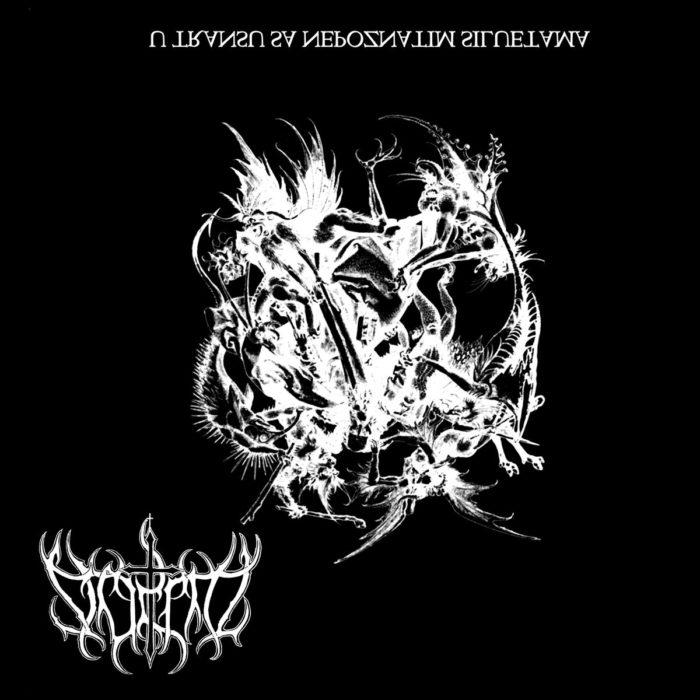
Article by Lance Viggiano.
U Transu Sa Nepoznatim Siluetama presents a longing, melancholic, and nostalgic view on black metal ripped straight out of the playbook that enabled artists such as Alcest to score big with the empathetic loner crowd. On the surface, this music is presented as your standard affair of devil music yet it is bereft of even one note of existential weight or tantalizing, decadent forbiddance which typically characterizes Faustian gambits with the dark. The music swings, bounces, pops, and dances in the light. It is so light in fact, that gravity actually helps uplift these sounds.
Then there is the overwhelming familiarity which strikes the listener immediately. These are well-considered compositions that look backward for source material but otherwise fail to provide new meaning. The past is alive but it is practicable and pedantic. Zloslut shamelessly flaunts catchy and immediately gratifying candy culled from across the metal spectrum. A delicate and emotive arpeggiated tremolo-picked melody ripped right out of Norsecore will be seated right next to a Rotting Christ-style heavy metal motif. Burzum and Gorgoroth have their post cards along route 666 through the use of ringing bar chord breaks.
This is one of the rare albums where sloppiness, uncertainty, and disorganization could have been a boon as it would have colored the music with a wild charm and sense of adventure. The riffs are supposed to add up to a meaningful experience but the stark reality is that this is a Now That’s What I Call Black Metal! recollection of genre hits. Quite possibly the most radical statement this album could have made would have been allowing the genre-verboten blues to blossom into a David Gilmour solo on the first proper track.
Listen to and download U Transu Sa Nepoznatim Siluetama for free from Zloslut’s Bandcamp page.
36 CommentsTags: 2016, Black Metal, modern metal, pop metal, re-review, review, Serbian Black Metal, U Transu Sa Nepoznatim Siluetama, zloslut
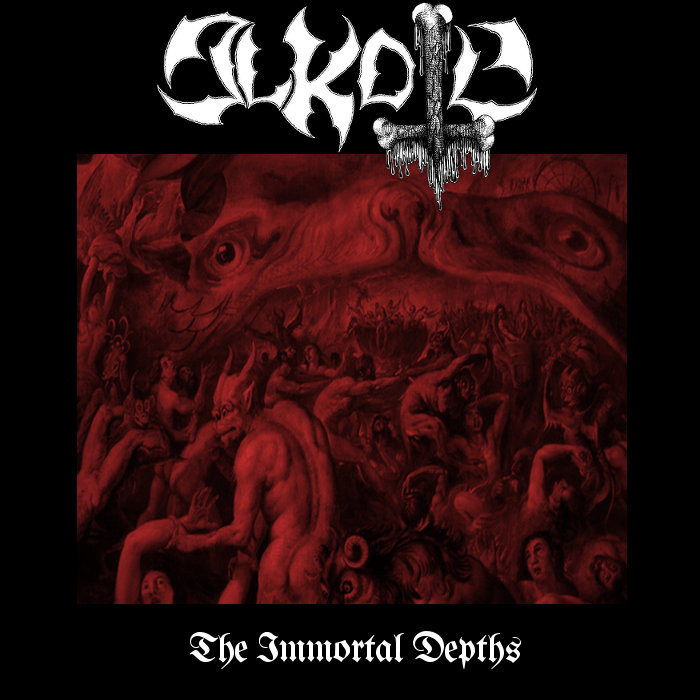
Article by Corey M.
Whatever the musicians of Olkoth are physically doing with their instruments is nothing extraordinary but the idiosyncratic placement of notes and the resulting higher-level structures that emerge in their songs are truly something to behold. “Rollercoaster” and “Labyrinth” metaphors abound when writers try to describe metal with this sound. The most appropriate real-world visual analog would be an ancient sculpture, specifically what can be found in Mesoamerican architecture: Vivid figures and images symmetrically organized and actually making up the architecture itself rather than being mere aesthetic reliefs. Hearing this music is much like view ancient reliefs: there is an obvious narrative even though the specific symbols belong to alien cultures and distant epochs. The representations ring true by striking a Jungian chord deep within the recesses of our collective unconsciousness. However, these super-emotive runes are not activated at will; the listener must cultivate a passive mindstate to avoid projecting their own idiosyncratic symbolism onto the music. That will only serve to obfuscate the encoded messages just waiting to be decrypted.
Listen to and download The Immortal Depths EP for free from Olkoth’s Bandcamp page.
21 CommentsTags: 2016, Black Metal, EP, Olkoth, review, The Immortal Depths
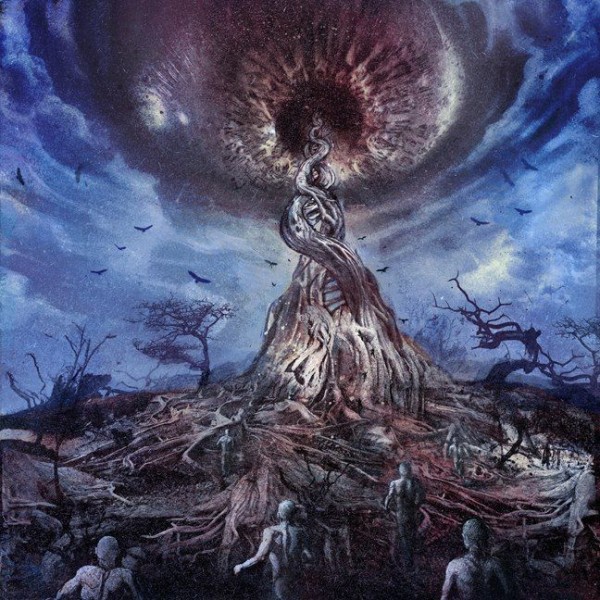
Article by David Rosales.
On their tantalizing debut album, Zealotry showed charm that often characterizes first releases. Debuting bands earnestly try to capture the aura of the music as they juggle with the technical aspects of playing it. First albums often come off as awkward or even flawed but there still containing endearing and thoroughly captivating elements. Many groups lose this enchantment in their sophomore album only to recover it with the third. This happened to Sepultura, who reached the pinnacle of their transcendental contributions on their only death metal album, Morbid Visions. They followed it with a boring mass of riffs with no heads or tails. Their much superior 1989 speed metal album, Beneath the Remains, fortunately corrected this. Hopefully, this will be the case with Zealotry as well.
The Last Witness plays like an extension of The Charnel Expanse‘s final track, “The Unmaking”, the least structured song on the album. The band tangentially explored the technical ramifications found by playing their particular style. From the creators’ perspective, this seemed like a clear path. In taking this choice to focus on a narrower voice, the evocative deficiencies of that streamlined, tremolo-picked, sequence-of-riffs approach had to be compensated for. This was completely ignored and instead there is a heavier emphasis on playing the technical parts of the songs correctly.
Musically, there is a lot of worthwhile content here; It just doesn’t tell a story as much as give scattered visions that are not arranged properly, do not have clear beginnings, and even less conclusions. The painstaking composition in a self-conscious style with a corrective attitude is extremely promising. This is admittedly the hard route as it requires extreme discipline; it is the classical composer’s way for reaching to perfection on all fronts. However, composers need many, many errors before turning trial into triumph.
As it stands, The Last Witness is a collection of exquisite details into which a very attentive reader can dive. He will discover many forms but nothing solid enough to materialize a clear vision. In part, this is due to the tendency towards extreme variation and superficial indulgence of musicianship, and too much escapism in the codas. Follow the title track attentively to hear what I am referring to. The problems here mirror those of Monsieur Tougas on his side project except that Zealotry has a much more individualized voice.
Zealotry would also do well to stay away from the death and war metal influences with atmospheric pretensions seen in the empty music of Phobocosm. Instead, they should work on their motific death metal, develop the themes to establish long-range links, and fully utilize their proper sense of breathing space. Zealotry should play to their strengths instead of diverging horribly and incoherently as in the final track, “Silence”. I am sure with practice and discipline, the time will come when this band will dominate a wider range of expressions. For now, shaping up this very narrow music into that which breathes, lives, and envisions a story is still a goal.
Readers may listen to The Last Witness on Zealotry’s Bandcamp page.
3 CommentsTags: 2016, death metal, review, techdeaf, techdeath, Technical Death Metal, Zealotry
“Punk’s not dead,” goes the old joke, “It’s only sleeping.” Since the mid-1980s, very little of interest has come from the punk community as it has struggled to deal with its popularity. Teenagers want rebellious music, but they want it to be safe enough that they can use it for those difficult teen years, then move on to lite jazz and album-oriented rock as they age.
As a result, punk became a market, and that market favored brain-dead angry rebellion that did not shake any actual foundations but simply attacked socially-acceptable enemies with a more angry approach. Punk went Leftist in the 1980s, but it is more accurate to say it “went bourgeois,” or searching for targets it could bash without really offending anyone. It is always acceptable to target cops and Hitler, but not so much to mention anything which could make us all doubt our participation in society.
The Cro-Mags were a breath of fresh air in this dying scene. Like other classics of hardcore punk — Amebix, Discharge, The Exploited, Black Flag — they paired a Leftist distrust of the profit motive with a right-wing view that human culpability at the individual level was destroying our society from within. This complex view makes for uneasy coexistence with people who depend on both profit motive and patriotic views of strong defense and economy.
Harley Flanagan, bassist and founding member of the Cro-Mags who identifies Lemmy Kilmister of Motorhead as his greatest influence, drove his band to create a form of punk that was actually rebellious. For many of us, “World Peace” was an early Red Pill, awakening us to the fact that the most cherished values of our society were in fact moronic illusions that were consequently quite popular. People love an excuse to turn off the brain and go with the flow.
Nothing as intense as the Cro-Mags could last, and after a brilliant first album (The Age of Quarrel in 1986) the band struggled with internal instability, putting out a speed metal influenced album (Best Wishes in 1989) and a softer, more contemplative and Hindu-influenced take on punk with Alpha Omega (1992) and Near Death Experience (1993). One version of the band released a followup in 2000, and several compilations have tried to resurrect the early material, most notably the demo/live compilation Before the Quarrel (2000).
Cro-Mags, the most recent solo offering from Flanagan, channels quite a bit of rage at the personality conflict behind the collapse of this once-great band, but also at the collapse of hardcore itself. Interestingly, it merges the speed metal era Cro-Mags with their earlier intensity to come up with a metal-influenced (but not metal-flavored) blast of rage and melancholic isolation.
Songs on this album take a form of simple riff loops with introductions and interludes, often fading out in explosive and sometimes bluesy solos. Musical focus targets a good solid riff and a strong chorus that plays off the tension in that riff, guided by the vocals of Flanagan which vary between angry riot shouts and a type of unnervingly emotional but aggressive singing that has never been done successfully in hardcore before.
Like most return albums, this is a foray that tests different waters. The band experiments with — or mocks — Pantera-style riffing on “I’ll Fuck You Up” and revisits punk and metal riff archetypes with earlier songs. None of these are off-the-shelf however; in each one, the riffing remains distinct enough to be its own entity, a hybrid of Motorhead and punk hardcore and the aggressive speed metal from Slayer, Exodus and Metallica with a voice unique to itself.
The question before the reviewer is not whether Cro-Mags is a decent comeback album or an acceptable substitute for the Cro-Mags, but whether the music stands on its own. Over the course of several listens, I have concluded that it deserves listening on its own merit. These are aggressive but thoughtful songs with a core of dissident outlook not toward politics, but toward humanity and its default impulses as a whole, and in so doing it continues and enhances the best of what hardcore punk had to offer.
9 CommentsTags: 2016, cro-mags, crossover thrash, Hardcore Punk, Harley Flanagan, punk, review, Speed Metal
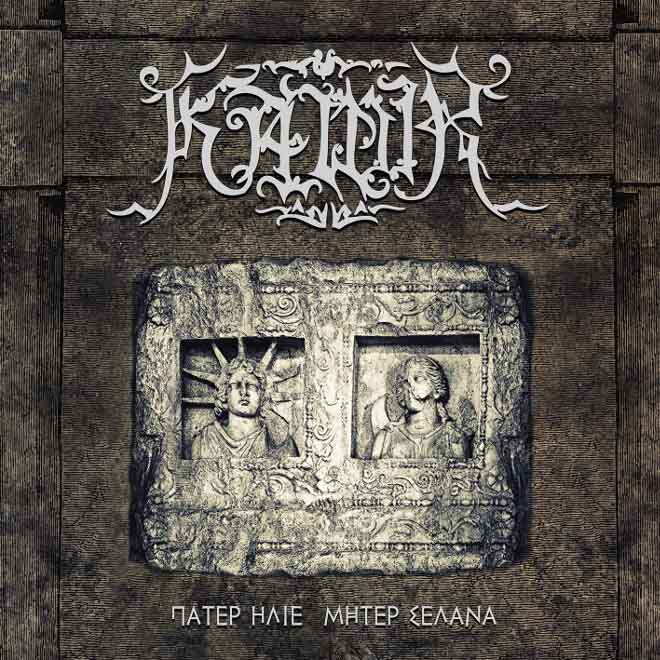
Article by David Rosales.
Kawir’s Father Sun Mother Moon strikes one as simple and mediocre pagan pop metal. From the recycled tunes to the standard, swinging rhythms of the genre that make actual metalheads cringe, Kawir has collected and presented them all to us on their new album. Kawir debases their music, pandering in the same way as those worthless politically-correct pop-dressed-as-metal bands like Turisas do. It really does sound like these Greeks could have been hanging out with Congressman Freddy Lim and Jesse ‘Djent-Black’ Liu of Cthonic, or drinking beers with the geeks from Tengger Cavalry. All these accusations are well deserved. The album therefore deserves to be dismissed as third-rate pap. Despite this, it is useful to look at this inconsequential list of boring tunes in terms of their de-evolution from Kawir’s previous album, Isotheos.
The concrete symptoms of banality and mediocrity can be found in the overall decline in richness of melodies and rhythms. Melodies have been shortened: they return much quicker to the root tone and rely more heavily on simple-silly rhythms ‘typical’ of Pagan pop. The variety of the types of melodies (that is the different arrangements of the motifs and their variations) are much less in number. Exactly the same with the rhythm guitars: less variety and where there was minimalism (which by definition, cannot be further simplified without loss of value), we now find a dumbing-down. The strict cyclic structures are far more evident in this album, replacing the quasi-linear Eastern European black metal which was used on their 2012 release. This uncreative disaster reaches unbelievable proportions when we encounter a dull track where after subjecting the audience to an ad nauseam repetition of a melody over a beer metal rhythm, Kawir simply fades out to avoid any shock to casual radio listeners in order to make it easier for the corporate broadcaster to place advertisements right after it.
While Isotheos melded melody and rhythm into a phrasal motific force, Father Sun Mother Moon clearly separates the paradigms of melody and rhythm. This in itself does not mean the end of the world but nothing is done to balance the combined simplicity. In fact, repetition plays an even greater role in filling out the runtime of this album: variations are less frequent, variation distance is smaller or unrelated, and single melodies or rhythms contain less content (movements from the tonic, manner in which they return to the tonic, temporary movements to different tonics, and even number of notes). Some sections on Father Sun Mother Moon reach the heights of the previous record but the overall quality is definitely lost.
2 CommentsTags: 2016, black 'n roll, Greek Black Metal, Heavy Metal, Iron Bonehead Productions, Kawir, melodic black metal, metal pop, modern metal, pop metal, review